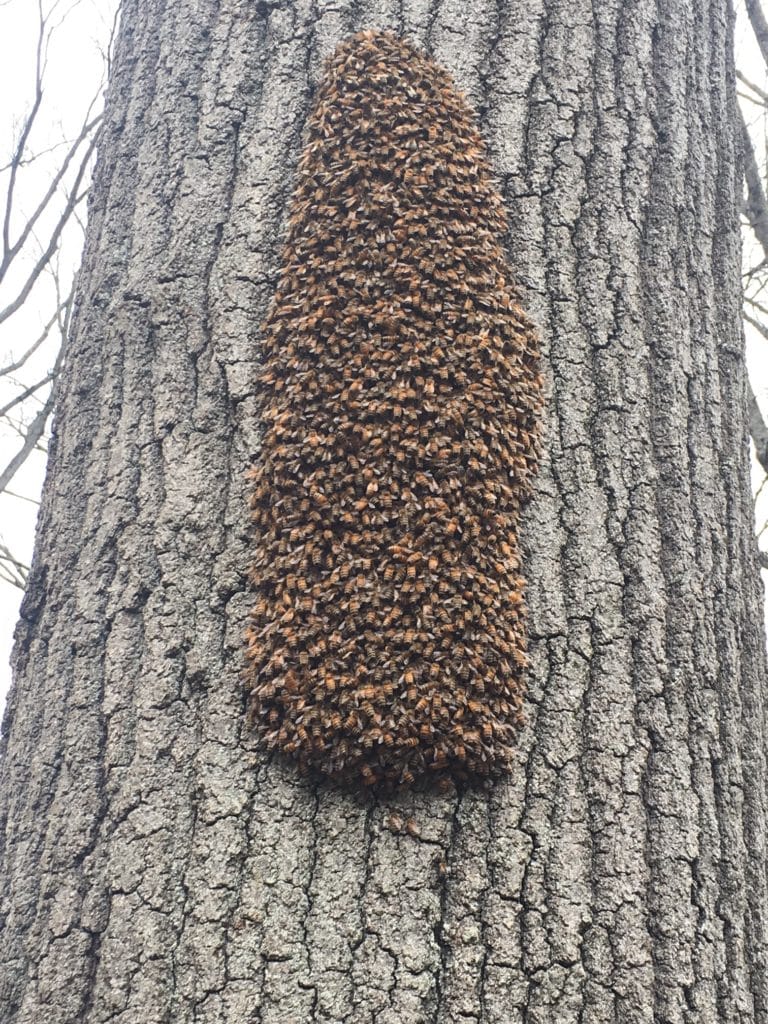
by Ruth Ann Grissom
May 8, 2018
We were less than a week into spring. The weather was cold and gray, but the landscape in my Charlotte neighborhood was Technicolor – emerald lawns, sunny daffodils, pastel phlox, Yoshino cherries and redbuds. Oddly enough, my eye was drawn to the drab trunk of a single willow oak, one of many lining the streets. About ten feet from the ground, there was a large, oblong cluster, golden against the mouse-brown bark. I recognized it immediately – a swarm of honeybees!
My husband, Marcus Plescia, is an erstwhile beekeeper. Over the past three decades, he’s tended many hives in the Uwharries. His inspiration was both practical and sentimental in nature – a more productive garden and a hobby shared with his English grandfather. In the early days, he ordered supplies from Brushy Mountain Bee Farm, but his best bees – and his best stories – came from local sources. There was the inexplicably ill-tempered colony raised by a gentle, elderly man in Asheboro and the laid-back bees he got from a salty guy off Highway 49 who smoked them with an ever-present menthol cigarette.
Honeybees face many challenges these days – mites, parasites, viruses and pesticides. Dedicated beekeepers resort to all sorts of interventions to keep their colonies healthy. Marcus takes a more hands-off approach. He’s often unable to check on them for weeks at a time, so he figures they have to be tough to survive in the wilds of the Uwharries. Needless to say, some of his colonies have lasted longer than others. One of them swarmed. He happened to notice a cluster of bees the size of a basketball on a nearby limb. By the time he read up on how to collect them and returned to the site, they had disappeared.
 Bee keepers don’t like a swarm – it can be a sign something is wrong and can weaken the colony that remains – but swarming is nature’s way of propagating the bee population. Bees like to maintain a certain proximity to their queen, so when a colony gets too large, they revolt. A colony will also overthrow a weak or infertile queen. This fascinating process takes just over two weeks. Midway into this period, the old queen leaves with some of the workers and drones. They cluster nearby while scout bees sally forth to find an appropriate site.
Bee keepers don’t like a swarm – it can be a sign something is wrong and can weaken the colony that remains – but swarming is nature’s way of propagating the bee population. Bees like to maintain a certain proximity to their queen, so when a colony gets too large, they revolt. A colony will also overthrow a weak or infertile queen. This fascinating process takes just over two weeks. Midway into this period, the old queen leaves with some of the workers and drones. They cluster nearby while scout bees sally forth to find an appropriate site.
Marcus was concerned about this particular swarm. In a suburban neighborhood, the bees might be tempted to relocate in the walls or attic of a house. If an exterminator is called, the outcome can be bad for everyone involved. The bees were also vulnerable to the cold, rainy weather. When bees swarm, they take a limited amount of honey to sustain them until they set up their new home. Even though they had access to plenty of flowers for gathering pollen and nectar, their chances of survival would be enhanced if someone provided a hive with an established comb and sugar water.
I quickly posted a plea for help on Nextdoor. Within hours, Libby Mack had come to the rescue. A beekeeper since 2003, Mack has completed the Journeyman level of the Master Beekeeper Program. She teaches classes for Mecklenburg Bee Keepers (http://www.meckbees.org/), is secretary of the N.C. State Beekeepers Association (https://www.ncbeekeepers.org/) and operates Charlotte Local Honey (www.charlottelocalhoney.com). She has hives in some of Charlotte’s most desirable neighborhoods – Myers Park, Eastover, Plaza Midwood and Elizabeth. She even has bees on the roof of the Westin Hotel (https://www.marriott.com/hotels/travel/cltcw-the-westin-charlotte/).
During a swarm, bees are especially docile. To collect them, Mack climbed a ladder and spritzed them with sugar syrup, making it harder for them to fly. She then brushed them into a homemade scooper – a milk jug with the top half cut away – and poured them into a hive. “Once you get the queen in the box,” she said, “the rest are eager to follow.” She noted this was a bit early for Piedmont bees to swarm, but once the colony committed to brooding a new queen, the date was set. They had no way of knowing their flight would coincide with such a raw spring day.
When Mack climbed her ladder to collect the swarm, she noticed bees flying in and out of a hole a little farther up the trunk. She referred to this as the “parent hive,” the source of the swarm. At some point, scout bees – perhaps from an urban beekeeper’s hive – had found a cavity created when a limb was removed from the tree. I’m glad to have these self-sufficient honeybees as neighbors, and I’m grateful when they come to visit my front-yard vegetable garden.
Swarm season continues into early summer. If you find a honeybee swarm, don’t call an exterminator; contact a local beekeeper.
In Charlotte http://www.meckbees.org/swarms.html.
In Montgomery County https://www.facebook.com/MCBANC/ or (910) 387-2891.